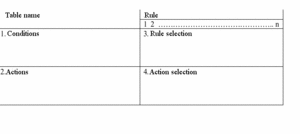Decision table
| Decision table |
|---|
| See also |
Decision tables are one of the basic techniques used in solving problems and decision making. Using decision table one can in a concise way specify, under predetermined conditions, what actions should be taken. Decision table is a specific way of describing a set of related decision rules.
Structure of decision table
Each table is divided into four main fields (S. Wrycza 1996, s. 120-121):
- Conditions - formulation of the necessary conditions in the process of deciding, the definition of variables affecting the decision process,
- Actions - decisions, listing all the possible actions that can be executed on the assumption that specific combination of conditions contained in the first field of the array occurred,
- Selection criteria - there are presented all the states of individual conditions, indicators, values, Symbol placed in this field indicates whether the condition has been fulfilled or not (usually used symbols: "1" condition fulfilled, "0" condition is not met, "-" the condition is not significant).
- Action selection - contains symbols identifying that particular action should be performed (used symbols "X" - action should be taken, "-" actions should not be taken)
Advantages and disadvantages
Advantages of decision tables:
- They provide a clear and concise way to represent decision rules and conditions.
- They make it easy to identify and understand the relationships between conditions and actions.
- They can handle complex decision-making scenarios with multiple conditions and actions.
- They can be used to test different scenarios and evaluate the outcomes of different decisions.
Disadvantages of decision tables:
- They can become complex and difficult to read and understand for large and complex decision-making scenarios.
- They may require significant effort to set up and maintain.
- They may not be suitable for all types of decision-making scenarios, such as those that involve continuous variables or probabilistic outcomes.
- They may not be able to fully capture the nuances of human decision-making and may not be able to replicate the reasoning process.
Examples of Decision table
- A decision table can be used to decide how to handle a customer complaint. For example, a decision table could be used to determine what type of compensation should be offered to a customer based on the severity of the complaint, the customer's history with the company, and other factors.
- A decision table can be used to help with scheduling tasks. For example, a decision table could be used to determine the order of tasks based on the resources that are available, the urgency of the tasks, and other factors.
- A decision table can be used to help with traffic management. For example, a decision table could be used to determine which routes should be taken to avoid traffic and which routes should be used for faster travel times.
A Decision table is just one of the many techniques used to solve problems and make decisions. Other approaches related to decision tables include:
- Cause and effect diagrams: This is a problem-solving technique that is used to identify and analyze the causes of certain problems or events. It helps to identify the root causes of a problem and helps to determine the best solutions.
- Flowcharts: This is a graphical representation of the steps or decisions that need to be taken in order to reach a given goal. It is used to show the logical flow of a process.
- Pareto Charts: This is a bar graph that is used to analyze the relative importance of different factors. It helps to identify the most important factors and prioritize the decisions.
- Brainstorming: This is a problem-solving technique that involves the gathering of ideas from a group of people. It helps to generate new ideas and solutions to problems.
Overall, decision tables are just one of the many techniques used to help solve problems and make decisions. Other approaches can also be used to analyze problems, identify root causes, assess the relative importance of different factors, and generate new solutions.
References
- Wang, G. Y., Yu, H., & Yang, D. C. (2002). Decision table reduction based on conditional information entropy. CHINESE JOURNAL OF COMPUTERS-CHINESE EDITION-, 25(7), 759-766.
Author: Krzysztof Wozniak

